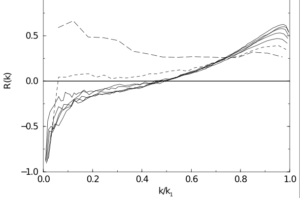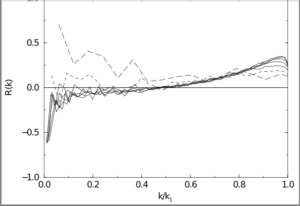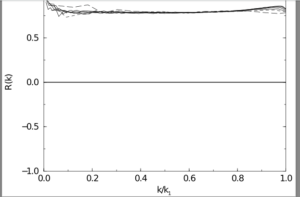Two-time correlations and temporal spectra
Two-time correlations and temporal spectra
I previously discussed this topic in my posts of 25 February 2021 and 10 March 2022. In the succeeding months I have become increasingly aware that there is dissension in the literature, with people citing the temporal spectrum as $\omega^{-2}$, if the arguments of Kolmogorov apply; and $\omega^{-5/3}$, if convective sweeping applies. Statements about these forms are often made without any supporting reference, so my next step was to identify the sources; and then try to make a critical assessment of both forms and their relationship to each other. In fact the source of the first result seems to be the book by Tennekes and Lumley [1], while the second form is due to later work by Tennekes [2]. So here I will make a start by outlining the general problem, in order to fix notation and definitions.
We begin with the general two-point, two-time correlation tensor $R_{\alpha\beta}(\mathbf{x},\mathbf{x’};t,t’)$, where $\alpha$ and $\beta$ are the cartesian tensor indices, taking the values $1,2$ or $3$. The correlation is defined in terms of the velocity field $u(\mathbf{x},t)$, thus: \begin{equation}R_{\alpha\beta}(\mathbf{x},\mathbf{x’};t,t’)=\langle u_\alpha(\mathbf{x},t)u_\beta(\mathbf{x’},t’)\rangle, \end{equation} where the angle brackets denote the ensemble average. In everything that follows we will restrict our attention to homogeneous turbulence and consider a fixed point in space. This means that we may simplify the notation by omitting the space variables, and write the correlation tensor as: \begin{equation}R_{\alpha\beta}(\mathbf{x},\mathbf{x’};t,t’)=R_{\alpha\beta}(t,t’). \end{equation} Then, for generality, we may introduce the sum and difference variables for the times, as: \begin{equation} \mathcal{T}=(t+t’)/2 \quad \mbox{and} \quad \tau = (t’-t). \end{equation} Accordingly, the two-time correlation tensor may be written in the form: \begin{equation} R_{\alpha\beta}(t,t’) = R_{\alpha\beta}(\mathcal{T},\tau) \end{equation} We still have one more restriction to make: Tennekes and Lumley restrict their attention to isotropic turbulence, which means that we can replace the correlation tensor by a single scalar correlation function which we will denote by $R_E$, where the subscript $E$ denotes `Eulerian’. Thus, for isotropic turbulence, \begin{equation}R_{\alpha\beta}(\mathcal{T},\tau) \rightarrow R_E(\mathcal{T},\tau), \end{equation} In a later post we will introduce the Lagrangian correlation function.
Now, at this stage, we have imposed all the restrictions that Tennkekes and Lumley have made in specifying their problem. However their subsequent analysis seems to imply that they are also considering stationary turbulence and this is an important point. We will underline this fact by continuing to treat the problem more generally.
The energy spectrum $\phi_E(\mathcal{T},\omega)$ is defined by the Fourier transform, \begin{equation}R_E(\mathcal{T},\tau) = \int_{-\infty}^\infty \exp(i\omega \tau) \phi_E(\mathcal{T},\omega)d\omega,\end{equation}where $\omega$ is the angular frequency; and the Fourier pair is completed by: \begin{equation}\phi_E(\mathcal{T},\omega)= \frac{1}{2\pi}\int_{-\infty}^\infty \exp(-i\omega \tau)R_E(\mathcal{T},\tau)d\tau.\end{equation}
As a preliminary to considering the inertial-range form of $\phi_E(\mathcal{T},\omega)$ we need to establish its dimensions. If we integrate the spectrum over all frequencies, we have: \begin{equation} \int_{-\infty}^{\infty}\phi_E(\mathcal{T},\omega)d\omega = U^2(\mathcal{T}),\end{equation} where $U$ is the root mean square velocity. Recall that $\mathcal{T}$ is the clock time, as opposed to the difference time $\tau$. From this relationship it follows that the dimensions of the spectrum are: \begin{equation} [\phi_E(\mathcal{T},\omega)] = L^2 T^{-1}, \end{equation} where as usual square brackets indicate the dimensions of a quantity.
At this point we assume stationarity, which is in effect what Tennekes and Lumley have done [1] and we omit the dependence on $\mathcal{T}$. Having, in effect, done this, they apply the well known argument of Kolmogorov to limit the dependence of the spectrum to the two independent variables $\omega$ and the dissipation rate $\varepsilon$. They state that the only dimensionally consistent result is: \begin{equation} \phi_E(\omega) \equiv f(\varepsilon, \omega) = \beta \varepsilon \omega^{-2},\end{equation} where $f$ is some arbitrary function, assumed to be a power and $\beta$ is a constant. Checking the dimensions, we find: \begin{equation} [\phi_E(\omega)] = (L^2 T^{-3})T^{2} = L^2 T^{-1}, \end{equation} as required.
Later Tennekes presented a different analysis [2] in which he argued that the inertial-range temporal spectrum would be determined by convective sweeping and this led to the result: \begin{equation}\phi_E(\omega)= \beta_E \varepsilon^{2/3}U^{2/3}\omega^{-5/3}. \end{equation} It is readily verified that this result has the correct dimensions, thus: \begin{equation} [\phi_E(\omega)] = (L^2T^{-1})^{2/3}(LT^{-1})^{2/3}T^{5/3}= L^2T^{-1}.\end{equation}
It should be noted that irrespective of the merits or otherwise of this analysis by Tennekes, it is limited to stationary turbulence in principle due to omission of any dependence on the clock time $\mathcal{T}$. In future posts I intend to give some critical attention to both these theories.
[1] H. Tennekes and J. L. Lumley. A first course in turbulence. MIT Press. Cambridge, Mass., 1972.
[2] H. Tennekes. Eulerian and Lagrangian time microscales in isotropic turbulence. J. Fluid Mech., 87:561, 1975.


